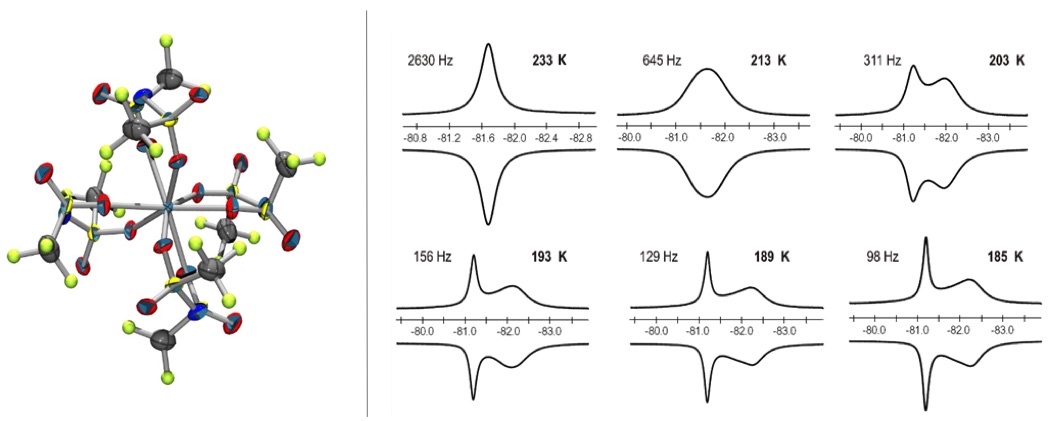Gadolinium Complexes Exhibiting Ultra-fast Ligand Self-exchange in Ionic Liquids for Application in NMR Field Probes
The technology used in Magnetic Resonance Imaging (MRI) relies on the observation of nuclear magnetic resonance (NMR) during complex choreographies of time-varying magnetic fields. Hardware imperfections as well as other external perturbances influence these field evolutions, limiting image quality and the feasibility of high-performance methods. Continuous concurrent magnetic field monitoring1 is a method for probing the spatiotemporal magnetic field evolution in an MR system by the usage of a set of NMR field sensors. For these sensors, highly homo-perfluorinated liquid compounds with short fluorine NMR relaxation times (T1 and T2 < 1 ms) are required. Effective relaxation enhancement requires a close contact between the 19F atoms and a paramagnetic centre – ideally in the first coordination sphere. Herein we present that a homo-perfluorinated ionic liquid in which the anions also act as ligands for the paramagnetic metal complex, offers such a possibility. The model Gd(III) complex [NnBu4][Gd(Tf2N)4] (Tf2N-= bis(trifluoromethylsulfonyl)imide), obtained from the reaction of its precursor [Gd(NTf2)3] with [NnBu4](NTf2), shows the extension of the coordination sphere from six to eightfold with transoid configuration of the NTf2 ligands. Hence, the solution of the [Gd(NTf2)3] in ionic liquids of the triflimide type [cat+][Tf2N-] (cat+=AMIm=1-allyl-3-methylimidazolium, EthylMIm or PR3R’+) is shown (by evaluation of exchange rates of the non-paramagnetic parent Yttrium compound) to yield a single 19F signal, reflecting rapid ligand self-exchange, and relaxation times in the sub-millisecond range as targeted.

Figure 1. ORTEP of [NnBu4][Gd(Tf2N)4]. Cation omitted and fluorides shown as spheres for clarity. The transoid configuration is clearly visible for the [NTf2-] ligands. Ellipsoids except for fluorides are drawn on the 30% probability level.
Figure 2. Comparison of observed (upper) with calculated (lower) 19F NMR (282.39 MHz) spectra of a mixture of [Y(NTf2)3] with [EthylMIm][NTf2] (1:1.5) in CD2Cl2 displaying line broadening, coalescence and splitting into two signals upon cooling.
[1] C. Barmet, N. De Zanche, B. J. Wilm and K. P. Pruessmann, Magnetic Resonance in Medicine, 2009, 62, 269.